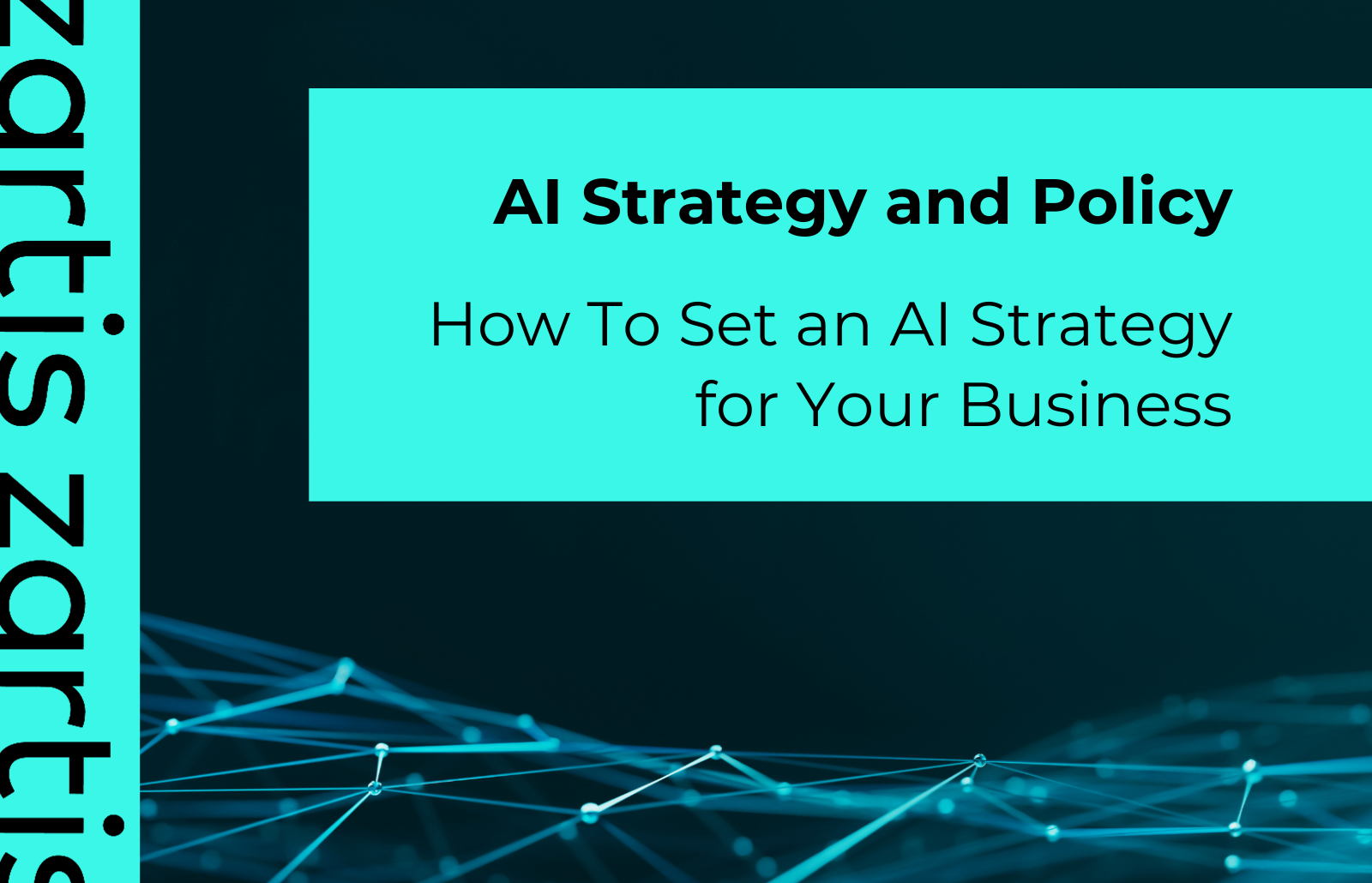Today, businesses of every size implement an AI strategy to improve their business. AI technologies like machine learning (ML) and robotic process automation (RPA) enable companies to automate processes, gain data-driven insights, and make more accurate predictions.
For example, Netflix uses AI to recommend shows based on your viewing history. Spotify has an algorithm that creates customised playlists tailored to your music tastes.
Some small brands use Al-based chatbots for their customer service, which can answer basic questions from customers, provide information about products and services, and route more complex queries to human agents.
This guide will walk you through developing and implementing an AI strategy tailored to your business needs without compromising AI policies. You’ll learn to identify AI opportunities, build a roadmap, assemble resources, and ultimately scale AI throughout your organisation.
What to consider before setting up an AI policy
When setting an AI policy, you want to ensure you do it right. So here are some key elements you have to consider:
1. Data quality
AI systems are only as good as the data used to train them. So, you must assess your data sources to verify their quality and credibility. Review your data for gaps or inaccuracies that could negatively impact work. If necessary, collaborate with experts to collect additional data or improve the existing one.
2. Choosing AI models
Select AI models that are appropriate for your needs and data. More complex models require more data and resources but may provide better results. Consult with professionals to understand the pros and cons of different model types and determine the most suitable for your organization.
3. Integration with existing systems
Determine how AI systems will integrate with your current tools and workflows. AI should enhance human capabilities, not replace them, so you have to consider how AI outputs will be reviewed and used in decision-making processes.
4. Balancing innovation with risk management
It is good to encourage experimentation to achieve your AI goals. However, you should establish guidelines to manage risks like unfairness, job disruption, or loss of human oversight. Put processes in place to monitor AI systems and mitigate unintended consequences.
Artificial Intelligence policy setting process
Policy setting process will ensure your AI strategy is comprehensive and actionable. The following are a few steps to begin:
1. Identify the right stakeholders
Stakeholders include those directly affected by the policy and those who can influence its success. These entities may include employees, customers, investors, community members, government agencies, and industry groups.
Use surveys, focus groups, interviews, and meetings to understand stakeholders’ needs and concerns. This engagement will help you identify potential challenges or roadblocks and help shape a more effective policy that works for everyone.
2. Identify potential AI use cases and risks
Brainstorm ways AI could enhance or optimise key business processes and what challenges may arise. Some possibilities include:
- Automating repetitive tasks like data entry or customer service inquiries
- Improving predictive analytics to forecast sales better or detect fraud
- Personalising the customer experience through recommendations or chatbots.
But also consider risks like losing human oversight, compromising data quality and integrity, or losing customer trust. Listing use cases and risks helps determine how to apply AI responsibly.
Make data-driven decisions, leading to increased efficiency and sustained growth. For example, digital agencies can grow with AI by employing machine learning algorithms to optimize ad placements, leading to higher campaign efficiency and increased ROI for their clients.
3. Clarify the policy’s goals
With valuable input from stakeholders and insightful brainstorming sessions, you can now articulate the intended outcomes of the policy and define measurable success metrics. Be specific about what problems the policy aims to solve and what results are expected.
For example, you may aspire to be more consistent with marketing (create two new blog posts every week), Grow your company’s online presence (get ten authoritative backlinks to your website each month), Or improve your first call resolution rates by 25 percent.
Defining these objectives will help align your Al strategy with your business goals.
4. Define the core components of your AI policy
Establish guidelines around AI development, use, and governance. For example:
- AI ethics: Fairness, transparency, privacy, security, etc., to create principles to uphold.
- Data governance: How data is collected, stored, accessed, and used to ensure proper consent and privacy.
- Accountability: Who is responsible for AI systems and outcomes? To assign oversight roles.
- Operational processes: Steps to build, test, monitor, and maintain AI responsibly.
5. Review and approve the policy
Ensure that the draft is written in simple, straightforward language so that there’s no room for ambiguity or misinterpretation. Then, leaders and stakeholders should review and approve it.
Once approved, communicate the new policy to all employees through official company channels. Explain the policy’s purpose and how it will impact employees’ roles.
Finally, provide opportunities for employees to ask questions to ensure they understand the policy.
4 Steps to implement a successful AI strategy
After establishing your AI policy, the next stage is translating it into practice. Here are five steps to put an effective AI policy into action:
1. Create an implementation roadmap
Developing an AI strategy should begin with mapping out a timeline of how and when you want to integrate AI into your operations. Identify the resources you’ll need and allocate responsibilities at each phase of AI integration.
That is, estimate the costs, infrastructure requirements, and the need for specialised expertise. This aspect of AI strategy development helps you get executive buy-in and funding lined up from the start.
2. Organise personnel training
Getting organisation-wide support and participation is key to successful AI policy adoption. To this effect, you’ll want to educate employees about how AI will impact their roles and the benefits it will provide.
Organise training sessions where you’ll teach them how to work with AI systems. You can start with a pilot project to test the waters before scaling up. Automate one workflow, learn from it, improve, and build from there.
3. Continual assessment and review
As you progressively integrate AI tools into different aspects of your business, you’ll have to monitor their performance and how well your staff interacts with them. You may find loopholes early on and close them to prevent damages or optimise operations.
To assess the effectiveness of the AI tools in review, you could have 2 groups – one that uses AI tools and another that does not and keep track of the performance. Once you collect metrics from the tools and it’s systems and run surveys within your workforce, you can compare with previous time periods numbers and see the change in results (e.g. number of hours saved to implement similar projects in the past without the AI tooling). The main point is to have a reference point and prove that AI is indeed improving the productivity.
4. Frequent audits and policy revisions
Now your systems are running smoothly, that’s cool, but the work doesn’t stop there. To maximise the benefits of AI, you must actively monitor, review, and improve your strategy for the long run.
As time passes, you’ll have to audit your AI systems to ensure they perform at their peak. You’ll also have to revise policies as needed to keep up with changes to AI technology, use cases, or government regulations.
Why is an AI strategy important for your business?
An AI strategy is crucial for any forward-thinking business. Here are a few reasons why:
1. Streamline operations and boost productivity
Using AI and machine learning, businesses can automate repetitive, routine tasks. This frees up employees to focus on more meaningful work that drives innovation. About 54 percent of business leaders say that AI solutions have increased business productivity.
2. AI provides actionable insights
Using AI for data-driven decision-making is a key competitive advantage. AI technologies analyse vast amounts of data to identify patterns and trends within customer data. Through these insights, marketers can understand their audiences better and refine their marketing efforts accordingly.
Imagine a company that uses AI to analyse customer data, discovering that a significant portion of their audience is interested in smart home devices. Armed with this insight, the marketing team launches a targeted campaign, offering promotions and content specifically tailored to more targeted customer segments. As a result, sales for smart home devices surge. Moreover, using AI, they might identify a segment of customers who are likely interested in the latest smartphone models and another segment interested in smart home devices, and drive more revenue through more customisation – demonstrating how AI-driven data analysis can swiftly translate into a competitive advantage through precise marketing strategies.
3. Enhances customer experiences
Chatbots, recommendation systems, and other AI tools can personalise interactions and make experiences more engaging. This strengthens customer relationships and builds brand loyalty. Research shows that 87 percent of users give neutral to positive feedback on chatbots globally.
4. Future-proofs your business
AI is the future, and early adopters are already reaping the benefits. Businesses that fail to implement AI risk falling behind competitors, losing market share, and struggling to attract top talent. Having an AI strategy in place ensures your business stays on the cutting edge. An Accenture study revealed that AI could boost profitability by an average of 38 percent by 2035.
Let’s help you implement a working AI strategy
You now have a solid roadmap for developing and implementing your business’s AI strategy and policy. However, you’ll likely feel stuck at some point as AI may seem complex. Don’t worry; we are here to help.
If you’re seeking professional guidance on AI strategy development and implementation, we’d be happy to help. We are a technology company providing AI consulting services and dedicated development teams.
We help businesses of all sizes to develop efficient and compliant AI strategies and policies. From the outset, we’ll help you outline a step-by-step plan for implementing your AI strategy. Even after your AI systems are up and running, Zartis offers ongoing support and guidance to ensure your strategy continues to drive real business value.
Contact us today to learn more about our AI policy and strategy development services.





